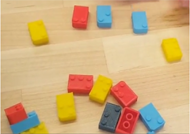Brai-Cks: A Didactic Toy To Learn Reading Braille (Universidad Iberoamericana Ciudad De México)
Abstract
One of the most important aspects of the education of people with visual disabilities has to do with access to information. Knowing the Braille system is an access medium for writing, music, literature, calculus, etc. Our project consists of a didactic toy to teach blind or low vision children how to read Braille. Brai-cks is fun and easy to use and can also be used by children without disabilities.

Introduction

When the child is learning to read, the size of the relief points is great, as the learning progresses, the size of the relief points decreases until the 6 points fit in the fingertip.
In schools, the amount of aids they have to teach a child to read Braille are very few. Our project consists of a didactic toy to teach blind or low vision children how to read Braille. Brai-cks is fun and easy to use and can also be used by children without disabilities. It comes in a box and it contains 230 individual pieces that include a collection of all letters and numbers from 0 to 9 and the arithmetic symbols. Each individual block is also printed with the corresponding letter. Block are large enough to be easy to manipulate and safe for small children. Each block has a notch that helps children orientate each piece. 3D printing instructions and drawings are open source.
This idea was initially developed in Brazil by Lew’Lara TBWA and Fundacion Dorina Nowill for the blind (Braille Bricks) and made available through the terms of Creative Commons.
Problem Statement
There is a need for an aid that allows blind children to learn to read Braille, while playing and, in turn, encouraging inclusion at schools.
Designs and Development


Testing and Results
Outcomes
Test 1

Test 2

3D Printing |
$ 5,577.00 mxn |
$ 298.63 USD |
Box |
$ 100.00 mxn |
$ 5.35 USD |
Total |
$ 5,677.00 mxn |
$ 303.99 USD |
Discussion and Conclusion
On the one hand, the prototype designed allows blind children to learn to read Braille in an easy and fun way. On the other hand, the prototype works as an arithmetic box, with which the child can learn to add, subtract, multiply or divide.
With this aid we help children with visual disabilities learn to read Braille and at the same time to generate interaction with children at schools and thereby break the barriers by promoting the inclusion.
We think that one of the most important features of the project is that it can be replicated by anyone who has a 3D printer, because the files for the print will be available (open source)
http://www.ite.educacion.es/formacion/materiales/129/cd/pdf/m5_dv.pdf
Acknowledgments and References
We thank María Torres Arpi Pous, Victoria Tufiño Portugal, Ixchel Cisneros, Tania Sánchez and Luisa Gómez Morin Calero for helping us to desing the tests.
We also want to thank the InIAT institute from Univeridad Iberoamericana Ciudad de México, for funding this project.